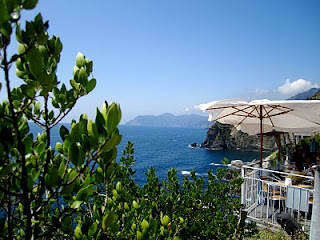Ciao, all! It has been a few days since I've updated my blog, so I've got a lot to catch you up on. First of all, my study abroad advisors in Prague finally gave us a tentative class schedule. We have an add/drop period where I can change some of my selections if I want. So far I have:
-Czech and Central European History Section II
-Art and Architecture of Prague: A Model of European City Development Section II
-Reading Prague: Literature-Architecture-Cultural History
-Czech Politics
-The Politics and Economics of the European Union Section II
-Beginning Czech Language, I Section 6

Back to Italy! I spent the last two days traveling in the South, basing my time out of the large city of Naples. Napoli is an interesting mix of people, culture, language, and natural elements. You can definitely tell that things run differently in the south of Italy, versus the north where I have spent the rest of my time. People are more carefree and things are a little more sketchy (mafia?).

I saw a few sights in Naples, including the National Museum of Archeology and the Duomo of San Gennaro. I also went on this really amazing tour of the Neapolitan underground. The underground is a former Greek and Roman aqueduct that was used to provide water to the residents of much of the surrounding area.

35 meters below and a cool 60 degrees, the underground tour gave us a glimpse of how the water system worked. Also, during World War II, Naples was the most heavily bombed city in Italy. Thus, thousands of residents fled underground and lived in this complex of former waterways. During some parts of the tour, we had to scale narrow passages by candlelight to get the best views of the subterranean world.

Later in the day, I took a 45-minute super ferry ride to the island of Capri in the Bay of Naples. Capri is basically the Monte Carlo of Italy, with lots of beaches, expensive shopping, and beautiful vistas.

I made my way to the very top of the mountainous island to the Villa Jove. These ruins were once a vacation house for the Roman Emperor Tiberius. It is easy to see why he chose this location, as the views of the island and the Bay of Naples are some of the most spectacular.

Capri is hard to describe in its natural beauty and manmade posh lifestyle. The people touring on the island clearly come from a LOT of money, and there are hundreds of luxurious homes to stay in. For dinner, I had a delicious pizza with salami, as Neapolitans are the inventors of pizza.

Most of Naples is very quite in August, as a large chunk of the population goes on vacation. Many restaurants and bars are closed for the whole summer since people flock to the islands in the Bay of Naples for vacation. After a night at a friendly Australian hostel, I made my way on the train line to Mount Vesuvius to the ancient Roman city of Pompei.

The result of the most famous volcanic explosion in history, Pompei was destroyed and preserved by a volcanic ash cloud from nearby Mount Vesuvius in 79AD. Almost every resident was killed instantly, and their bodies and buildings were kept intact by the very fine ash layer. Most people don't know that an earthquake destroyed much of the city in 62AD, so the residents were in the process of reconstructing their city at the time of the volcanic eruption. Therefore, the remains that we can see today are from a city already in ruins.

There are lots of amazing and well-preserved things to see in the city of Pompei. The sun is scorching there because there is little tree or shade cover, so lots of water and breaks are necessary. Luckily, there's a pretty good pizzeria tucked away in the former Temple of Jupiter. Some of the sights to see in the acres of expansive city are the houses of former residents, the temples to the gods, two ancient amphitheaters, and a glimpse into everyday life. Paintings and graffiti reveal much about the nature of the city, including how public election campaigns worked in a colony of Ancient Rome.

I am spending my last two days in Italy in Florence with my cousin before we head to Bologna on Sunday to see the city and catch my flight from there to Prague. I will update you next when I arrive in Prague to begin the next phase of my European adventures. Wish me luck, and CIAO!!



















































